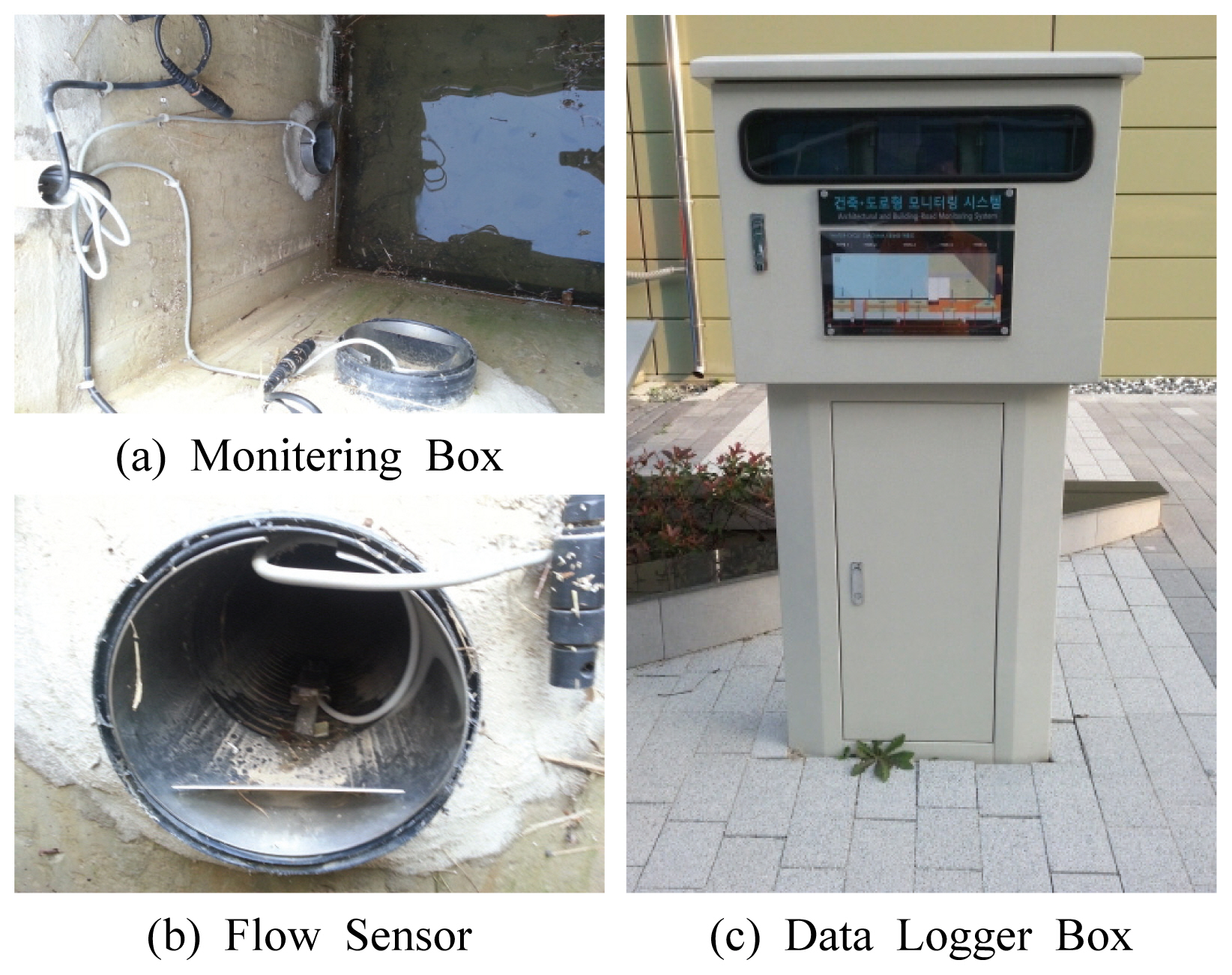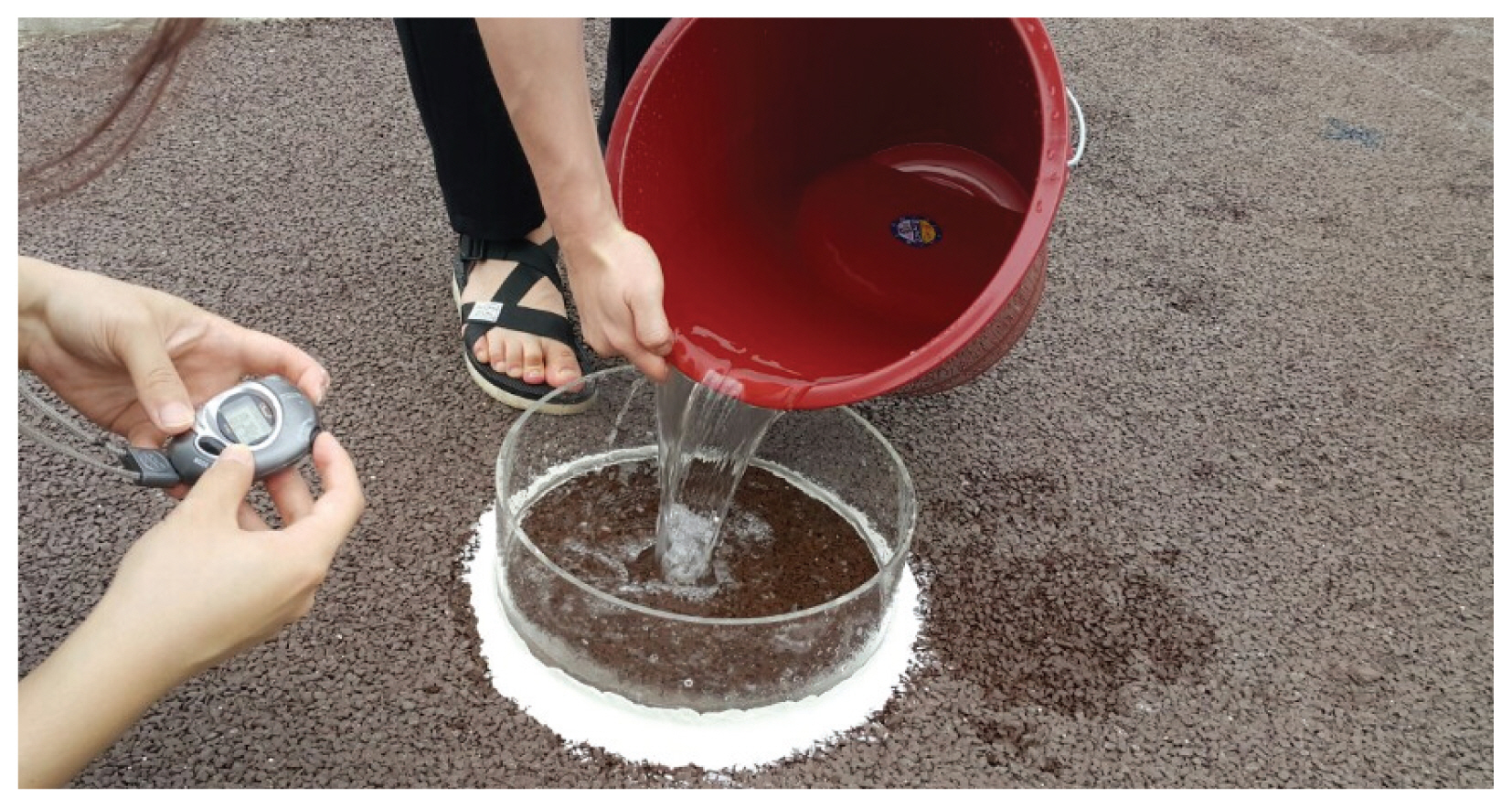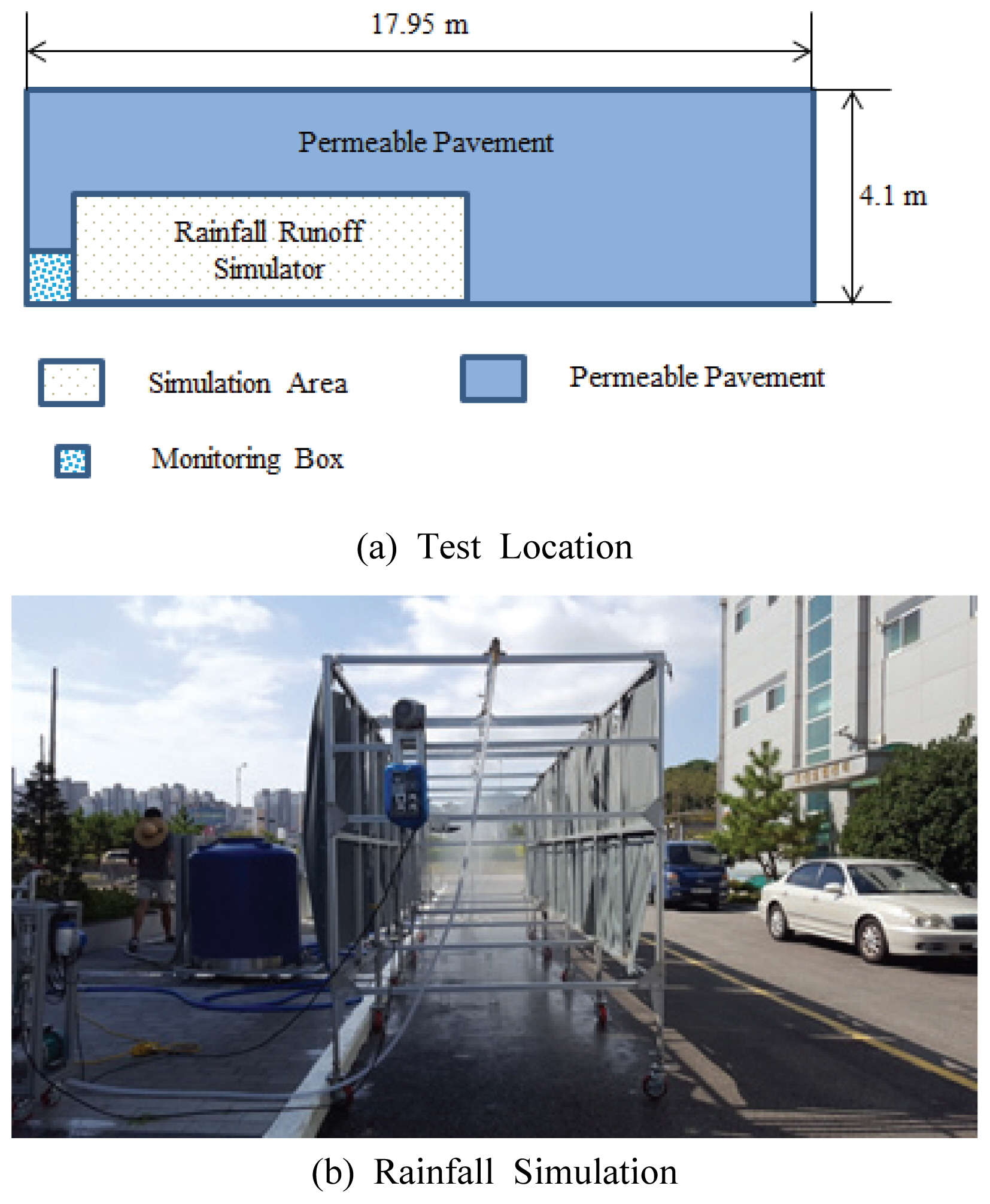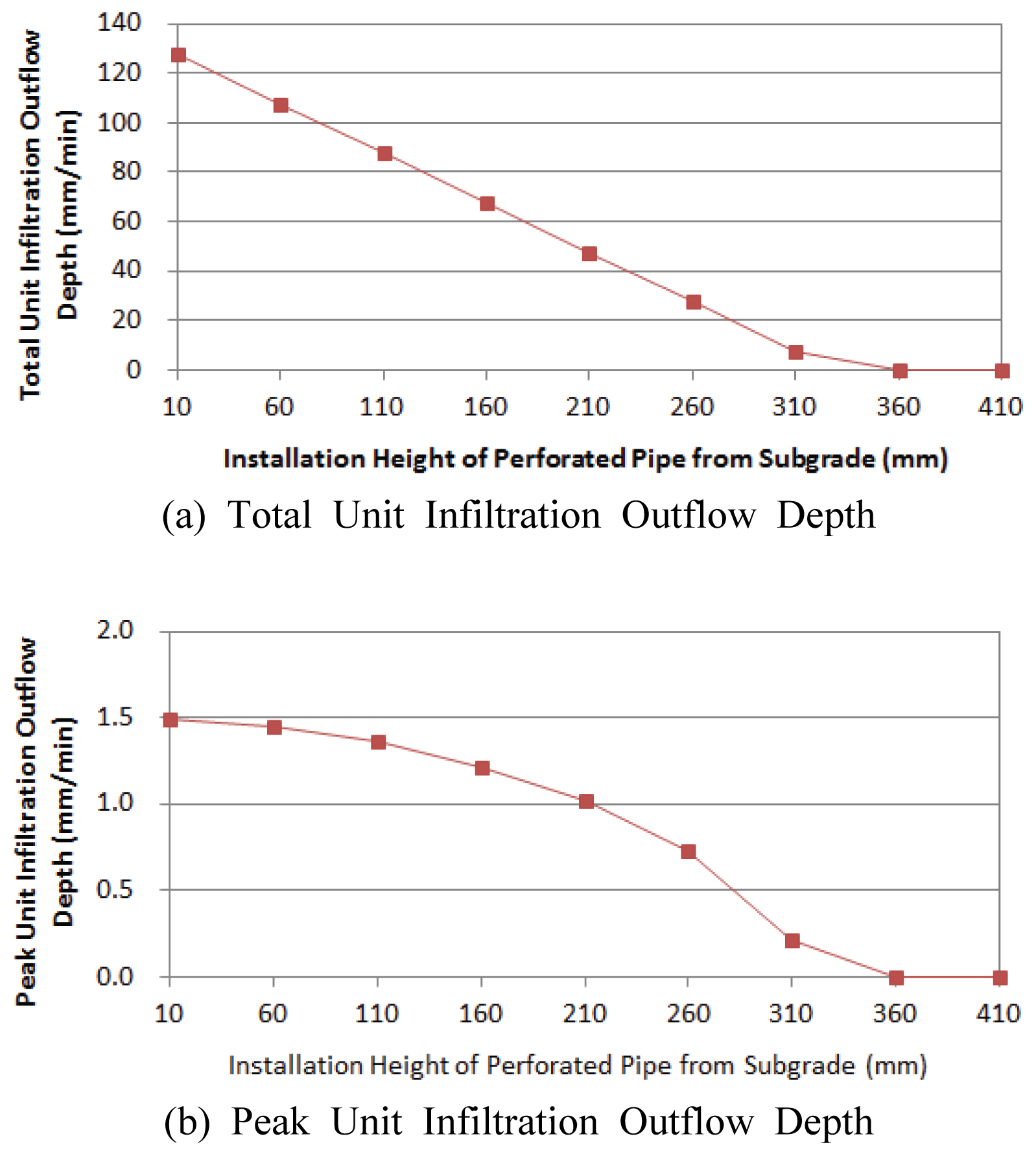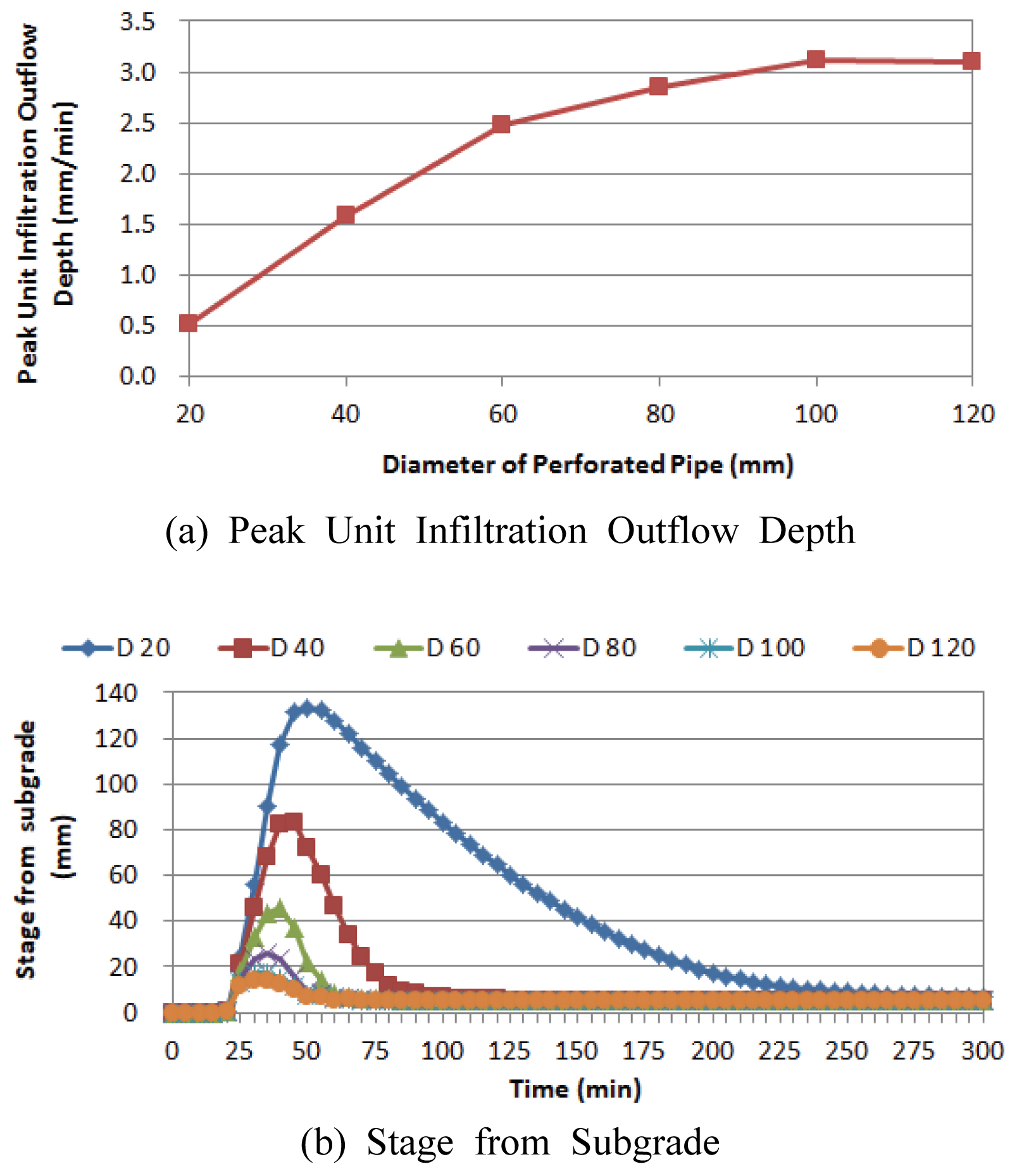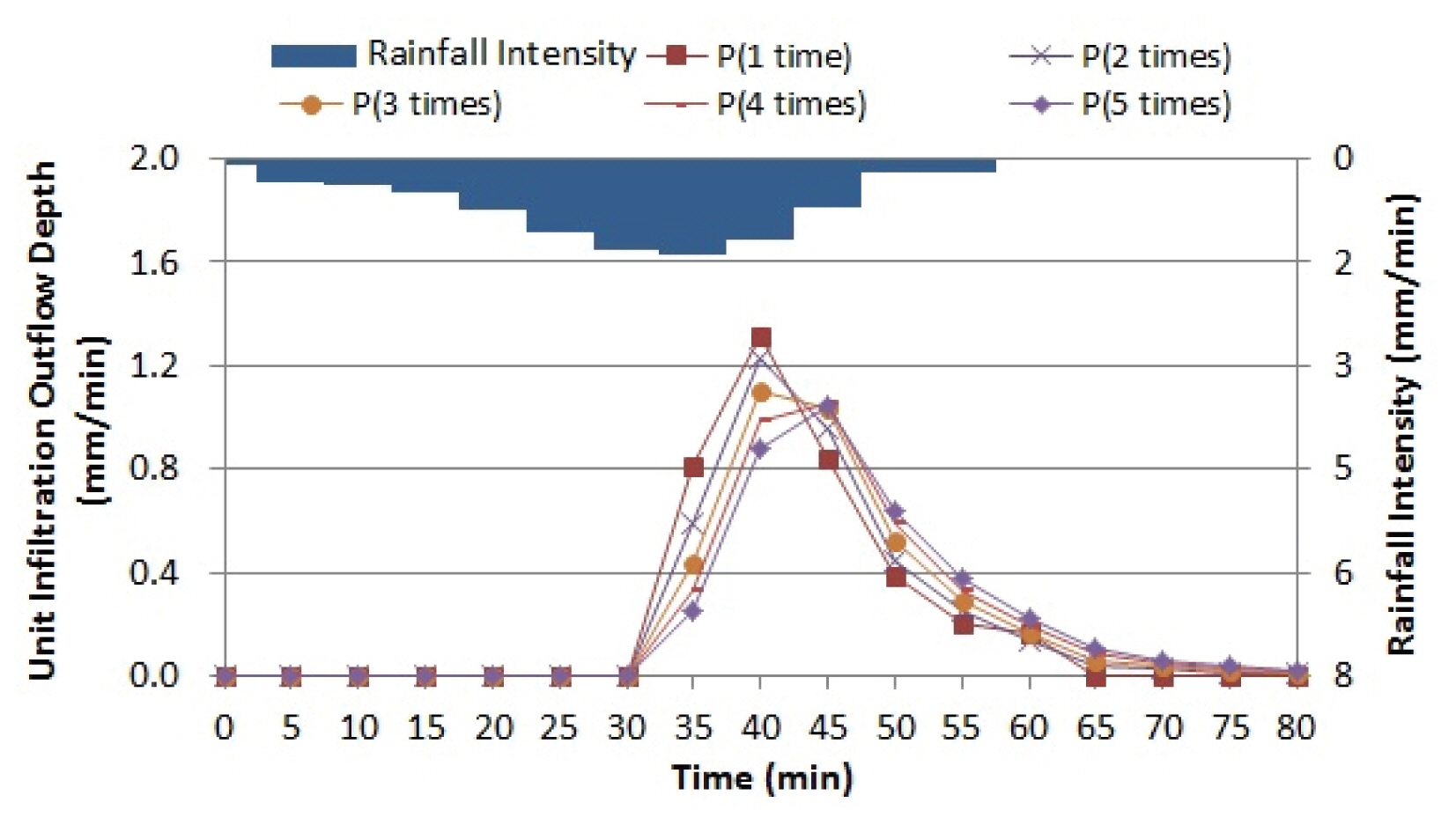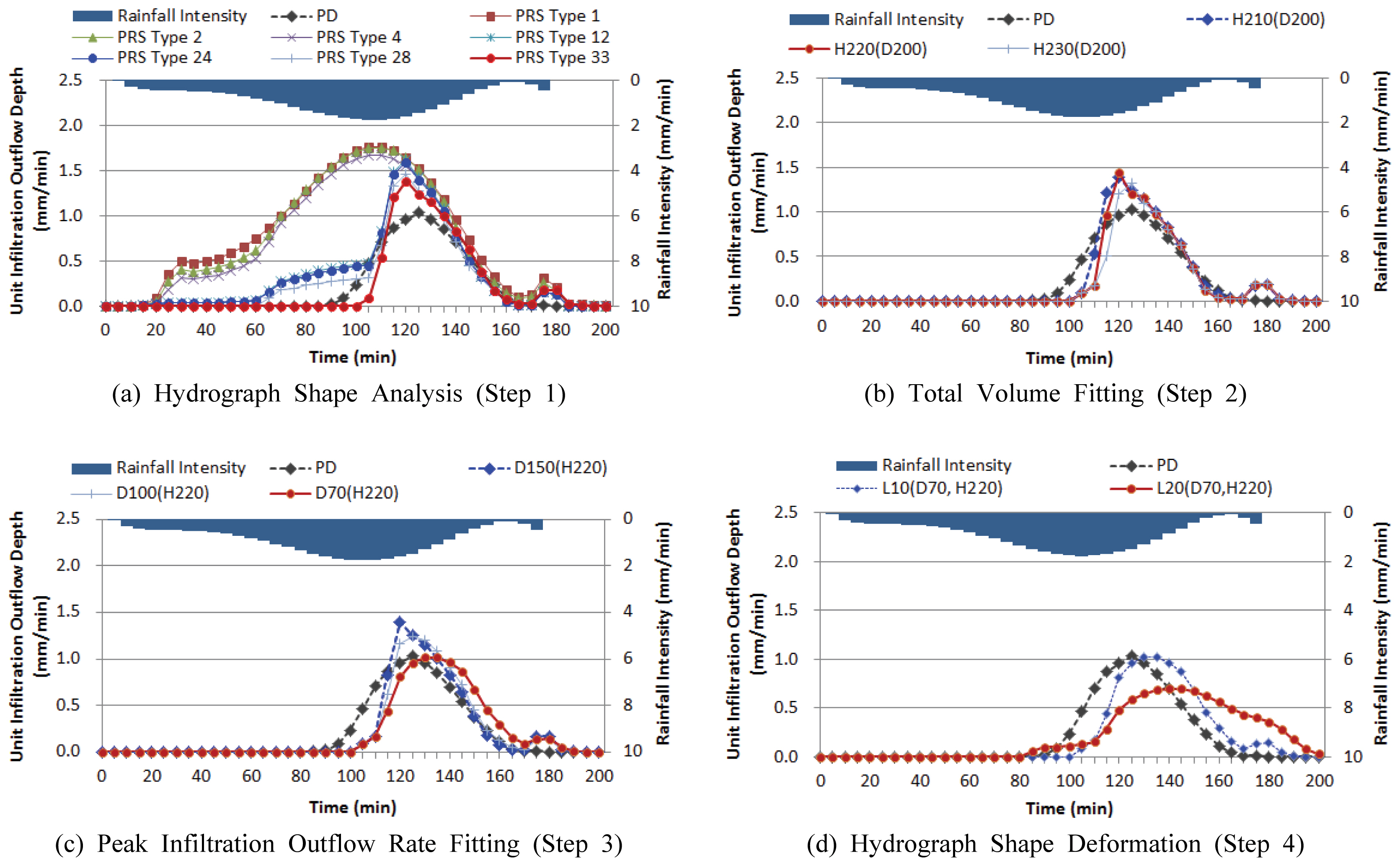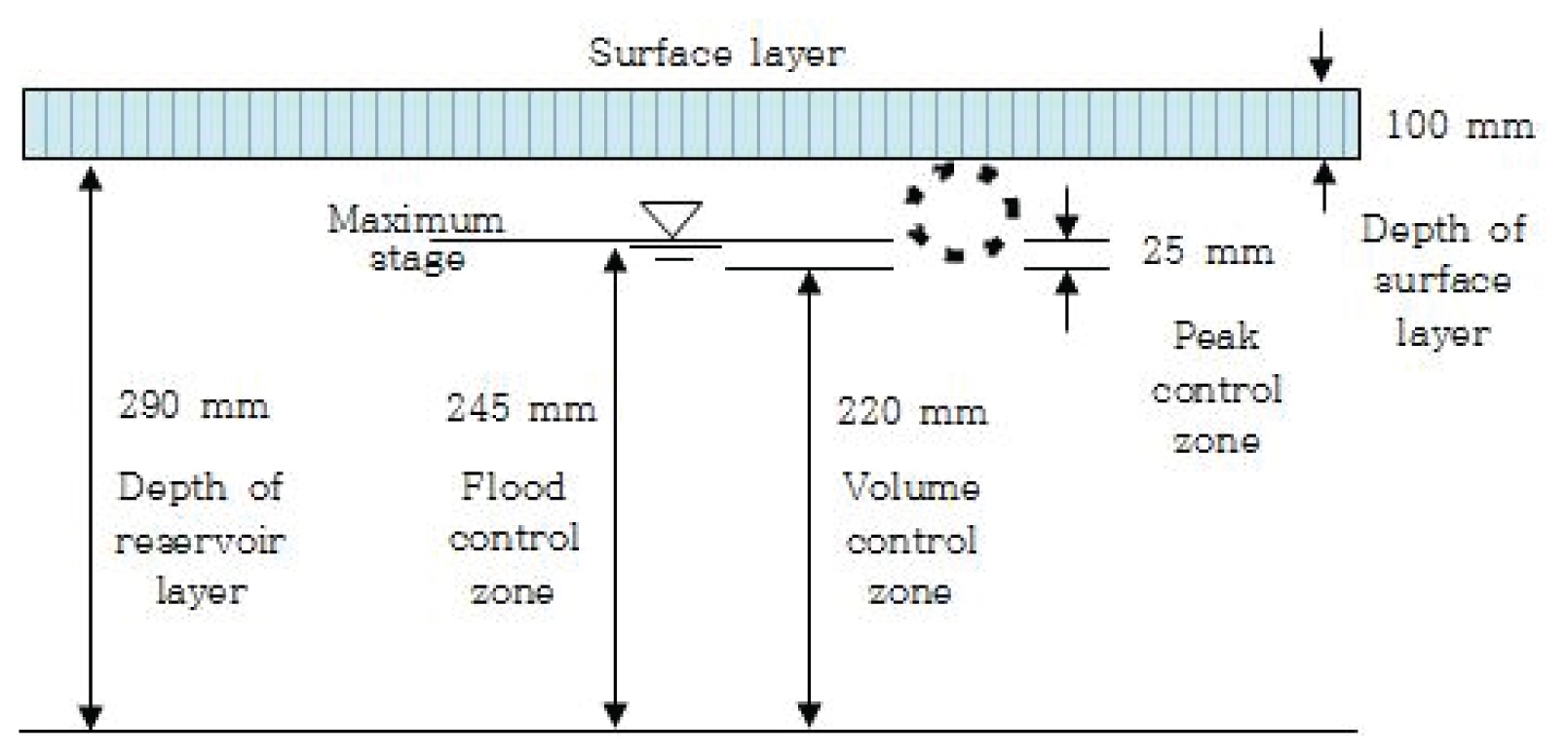 |
 |
- Search
| J. Korean Soc. Hazard Mitig. > Volume 19(2); 2019 > Article |
|
Abstract
The application of permeable pavements is known to be effective in reducing negative impacts such as increase in peak runoff rate and urban heat islands as the impervious surface increases. In this study, a detailed procedure for the hydrological design of permeable road systems and its example are presented. The study was carried out in the order of construction of demonstration-scale permeable road, analysis of rainfall-runoff data obtained from demonstration facilities, verification test of permeable road, construction of numerical design model, analysis of model sensitivity for design factor derivation, and development of the design procedure. The K-LIDM-R (K-LIDM-Road) was constructed as a design model by applying K-LIDM (Korea LID Model) to the permeable road. The model was confirmed by analyzing the data obtained through the empirical experiment, rainfall-runoff monitoring, and numerical model results. The permeable road system was constructed by linking the permeable road with the planter box, infiltration gutter, swale, etc., and the 33 most commonly used types of systems are presented. From the model sensitivity analysis, the height and diameter of the perforated pipe and the length of the unit road, which is the unit length of the perforated pipe connected with the urban stormwater drainage pipe, were identified as the major design elements. The design aims to reproduce the characteristics of the hydrograph prior to development by determining the detailed design values of the design elements and the thickness of the road base layer for a given design rainfall and permeable road system. The data obtained through this study can be used as basic data for the design of permeable roads, and the developed design procedure can be applied to the design of permeable roads connected with Low Impact Development facilities.
요지
투수성 포장의 적용은 불투수면 증가에 따른 첨두 유출률 증대, 열섬현상 등의 부정적인 영향을 저감하는데 효과적인 것으로 알려져 있다. 본 연구에서는 투수성 도로 시스템의 수문학적 설계를 위한 세부 절차를 제안하고, 예를 들어 설계과정을 보였다. 연구는 실증 규모 투수성 도로 구축, 실증 시설로부터 획득된 강우-유출 자료 분석, 투수성 도로 실증 실험, 설계 모형 구축, 설계 인자 도출을 위한 모형 민감도 분석 및 설계 절차 개발 순서로 진행하였다. 설계 모형으로 K-LIDM (Korea LID Model)을 투수성 도로에 적용한 K-LIDM-R (K-LIDM-Road)을 구성하였으며, 실증실험 및 강우-유출 모니터링을 통해 구축된 자료와 수치모형 결과를 분석하여 모형의 적절성을 확인하였다. 투수성 도로 시스템은 투수성 도로와 식물재배화분, 침투측구 및 식생수로 등 투수성 도로의 기능을 보완할 수 있는 저영향개발 시설을 연계하여 구성하였으며, 가장 일반적으로 사용할 수 있는 33가지 형태를 제시하였다. 모형 민감도 분석결과 설계 요소로 유공관 설치 높이, 유공관 직경 및 투수성 도로의 하부 집수암거가 도시 우수관거와 연결되는 단위 길이인 단위 도로 길이가 주요한 설계 요소로 파악되었다. 설계는 주어진 설계 강우 및 투수성 도로 시스템을 대상으로 하여 설계 요소의 세부 설계값 및 도로 기층 두께를 결정하는 과정으로 개발 이전의 수문곡선이 갖는 특성을 비슷하게 재현하는 것을 목표로 하였다. 본 연구를 통해 수집된 자료는 투수성 도로 설계시 기초자료로 활용될 수 있으며, 개발된 설계 절차는 저영향개발 시설과 연계된 투수성 도로의 설계에 적용할 수 있다.
도시 개발로 인한 불투수면의 증가는 개발 이전의 물순환 특성을 변화시켜, 홍수, 지하수위저하 및 비점오염물질의 유출증가로 인한 수환경 악화 등 여러 가지 사회 문제를 낳고 있다. 이러한 문제를 해소하기 위한 방안으로 도시 개발 단계에서부터 유역의 불투수면을 관리하기 위한 구조적 및 비구조적 노력이 이루어지고 있다. 불투수면적률 관리는 미국의 경우 최대불투수면적률을 설정하고 관련 규정을 통해 관리하는 방법이 주로 사용되고 있으며, 국내의 경우는 도시공간의 생태적 기능을 유지 또는 개선할 수 있도록 하는 생태면적률 개념을 적용하여 각 단계별 목표수준을 갖도록 제안하고 있다(NIER, 2014). 관련 규정의 지속적인 증가는 연관된 기술의 발전을 촉진시켰으며, 최근 도시에서의 침투효율성을 증대 시킬 수 있는 기법 혹은 설계 개념(US EPA, 2009)인 저영향개발(Low Impact Development, LID)에 대한 관심이 높아지고 있다. 미국 환경보호국(EPA)에서는 저영향개발 시설의 모의가 가능하도록 SWMM-LID (Ver. 5.0)을 개발하였고, 토지주택연구원(LHI, 2012)은 이를 활용하여 LID 기법인 침투트렌치, 침투통 및 빗물도랑의 효과를 검토하였으며, Park et al. (2013)은 도시 개발 전후 LID 기법 적용에 따른 물수지를 분석하였다. 최근 Kim et al. (2017)은 저영향개발 시설을 모형화 하여 각 시설별로 유출저감효과를 검토하였다.
저영향개발 시설의 하나인 투수성 포장(Permeable Pavement)은, 도심의 많은 부분을 차지하는 도로 및 주차장 등에 적용할 때 효과적으로 도시유출을 저감시킬 수 있는 방법으로, 1960년대 후기 홍수저감, 침루 증대 및 지하수 함양 등을 목적으로 제안되었으며, 1970년대부터 활발한 연구가 이루어졌다(Ferguson, 2005). 미국의 경우 투수성 포장의 설계는 일반적으로 해당 주 및 지자체에서 제시하는 침투 및 우수관리 관련 지침을 따르고 있으며, Smith (2006)는 Maryland의 관련 규정을 검토하여 투수 결합 콘크리트 포장(Permeable Interlocking Concrete Pavement) 설계 방법을 제시하였다. 영국의 The Precast Concrete Paving and Kerb Association (Interpave, 2005)은 복잡한 연산과정 없이 제시된 지도와 표를 이용하는 투수성 블록 포장 설계 방법을 개발하였다. 이 방법에서 지도는 영국의 지역별 강우 특성 정보를 담고 있으며, 표는 투수성 도로의 기층 두께를 선택하도록 구성되어있다. 일본은 투수성 포장 가이드북을 발간하여 간편한 설계 방법 및 기술을 제시하고 있으며 적극적인 활용을 권장하고 있다(Japan Road Association, 2007). 오스트레일리아는 투수 성능, 구조적 성능 및 기층재료에 대한 연구를 통하여 최소 7가지 종류의 투수성 포장 시스템을 개발하였다(Brian et al., 2008). 국내의 경우, 투수성 포장의 설계 기준을 제시하기 위한 노력의 일환으로, Ahn, Lee et al. (2017)은 실증실험을 기반으로 하여 서로 다른 투수성능을 갖는 투수성 포장의 CN 값을 제시하였다. Park et al. (2017)은 다목적 최적화 기법을 이용하여 투수성 포장의 비점오염 저감 효율 및 설치 비용 등을 고려한 투수성 포장의 최적 설치 방안에 대하여 검토하였다. 하지만, 투수성 포장에 대한 연구들은 대부분 유역 단위의 개발을 목적으로 수행되었거나 LID 시설의 성능을 지표화 하는 것으로 제한되고 있어, 시설의 세부 제원을 결정하는 설계 부분에 대한 연구는 미비한 실정이다.
본 연구에서는 투수성 도로 구성요소의 설계값을 결정하기 위하여, 33가지 형태의 투수성 도로 시스템(Permeable Road System, PRS)을 구성하였으며, 설계 세부사항을 결정할 수 있도록 K-LIDM (Korea LID Model)을 투수성 도로에 적용한 K-LIDM-R (K-LIDM-Road) 설계 모형을 개발하였다. K-LIDM은 국토교통부 건전한 도시물순환인프라의 저영향개발 및 구축⋅운영 기술 연구를 통해 개발된 모형으로, SWMM-LID 에서 모의할 수 없는 유공관 설정 등과 같은 LID 세부 사항을 모의 할 수 있도록 개발되었다. 투수성 도로 실증 시설을 구축하고, 실험 및 실측 강우 모니터링 자료를 활용하여 K-LIDM-R을 검정하였으며, 빈도강우를 사용한 민감도 분석을 통해 설계 주요 인자를 파악하였다. 개발된 투수성 도로 수문설계 절차를 예를 들어 제시하였다.
투수성 도로의 적용 사례는 증가 추세에 있으나, 수문현상을 연구하기 위한 자료 관리는 거의 이루어지지 않고 있어, 연구 자료로 활용할 수 있는 자료는 거의 전무한 실정이다. 본 연구에서는 기존 불투수 도로의 일부 구간을 투수성 도로로 변경하여, 실제 차량 통행 조건에서 실시간으로 자료 관리가 이루어지도록 실증규모 투수성 도로 및 모니터링 시스템을 구축하였다.
실증 시설은 2015년 8월부터 11월까지 약 4개월 동안 양산에 위치한 한국 그린인프라⋅저영향개발센터(Korea GI⋅LID Center)의 투수성 도로 실증구간에 시공하였다. 시설은 투수성 도로와 불투수도로가 연결된 형태로, 강우시 불투수도로에서 발생한 유출수가 투수도로로 유입(Surface Run-on)될 수 있도록 구성하였다(Fig. 1(a)). 투수성 도로의 설치는 경제성 문제로 여러 차로 중 일부에 적용하는 방안 등이 거론되고 있으며, 본 시설에 이를 반영하였다.
투수성 포장의 표층은 크게 투수성 아스팔트(Porous Asphalt), 투수성 콘크리트(Pervious Concrete), 투수블록(Permeable Interlocking Concrete) 및 격자포장시스템(Grid Pavement System)의 네 가지로 구분된다(ASCE, 2015). 하지만 지속적인 포장재료의 개발로 인하여 최근 투수성능 및 강도를 보완한 제품들이 많이 개발되고 있으며, 기존의 구분법으로는 명확한 구분이 되지 않는 재료들이 개발되고 있어 적용에 어려움이 있어왔다. 이에, American Society of Civil Engineers (ASCE)는 새로운 재료, 시설 및 기술의 평가가 이루어 질 수 있도록 신기술 적용을 적극 권장하고 있다. 실증 시설에 적용한 투수성 포장의 표층은 직경 10 mm 개립도 골재에 폴리우레탄(Polyurethane) 바인더를 배합하여 150 mm 두께로 구성하였다. Ahn, Jalmasco et al. (2017)은 동일한 바인더를 두 가지 크기의 골재에 적용하여, 투수특성을 평가한 바 있다. 하부구조는 자갈층과 모래층을 각각 250 mm 및 60 mm로 하였으며(Fig. 1(b)), 각 층의 공극률은 표층-자갈층-모래층 순으로 0.42, 0.41, 0.34로 조사되었다. 투수성 도로의 측면과 바닥면은 외부로 침투수가 손실되지 않도록 콘크리트를 사용하여 경계를 두었고, 침투수 배제를 위하여 콘크리트 바닥면에 직경 200 mm의 유공관을 설치하였다. 시공 순서는 콘크리트 격벽 설치 및 바닥 타설, 유공관 설치 및 기층 시공, 포장 및 다짐 순으로 진행하였다(Fig. 2).
유공관을 통해 유출되는 유량을 계측하기 위하여 도로의 끝부분에 모니터링 집수정을 시공(Fig. 3(a))하고 초음파 유량계(Fig. 3(b))를 설치하였으며, 안정적인 자료 관리를 위한 데이터 로거함(Fig. 3(c))을 설치하여 유무선 데이터 관리가 이루어지도록 하였다. 유량계는 25.4 mm ~ 4.57 m의 수심 및 0.03 ~ 6.2 m/sec의 유속을 대상으로 유량을 산정하며, 최소수심을 유지하기 위하여 유공관 끝 부분을 높여 시공하였다(Fig. 3(b)).
기상자료는 실증센터 옥상에 설치된 Automatic Weather System (AWS)에서 수집된다. 2017년 01월부터 안정적으로 자료가 수집되고 있으며, 웹기반으로 구축되어 실시간으로 분 단위 자료 확인이 가능하다(http://210.118.169.18/).
표면 침투율(Surface Infiltration Rate)은 투수성 도로 표면에서의 침투능력을 나타내는 지표 및 설계 요소로서 표면 침투율이 낮으면 지표유출이 발생하고, 반대의 경우 강우는 표층으로 모두 침투한다. 표면 침투율 산정을 위하여 투수콘크리트 및 투수아스팔트의 표면 침투율 산정에 사용되는 ASTM C 1701 (2009) 표준 방법을 사용하였으며, 네 지점에서 각각 두 번씩 측정하였다(Fig. 4). 표면 침투율은 평균 14.4 mm/s, 표준편차 3.0 mm/s로 측정되었다. 투수성 콘크리트의 시공직후 포화 표면침투율은 4.7 ~ 6.4 mm/s (Ferguson, 2005)로, 본 연구에서 사용된 투수재료의 표면침투율은 투수콘크리트보다 큰 것으로 나타났으며, 일반적인 강우는 모두 침투하는 것으로 판단하였다.
강우모사 실험(Rainfall Simulation Test, RST)은 투수성 도로에서 강우와 투수성 도로의 하부집수암거 유출(Subdrain Outflow) 간의 관계를 파악하기 위한 실험으로, 이동형 강우-유출 시뮬레이터를 사용하여 모의강우를 생성하고 투수성 도로의 하부 집수암거를 통한 유출량을 분석하였다. Jang (2018)은 투수성 주차장의 물순환 효율성을 검토하기 위하여 동일의 강우모사 실험을 수행한 바 있다. 기기는 2(W)× 10(L)×2.6(H) m의 강우분사 프레임(Frame) 상부에 노즐이 연결된 형태로 이동형 물탱크로부터 실험수를 공급받아 최대 약 250 mm/h의 인공강우를 모의 할 수 있도록 구성하였으며, 강우강도의 조절은 펌프 유출구에 연결된 유량계를 통해 이루어진다. 또한 바람에 의한 강우의 손실을 줄이기 위하여 방풍막이 설치되어 있다(Fig. 5(b)).
강우모사 면적은 강우모사 장치의 크기 및 물공급 등의 제한사항으로 인하여, 투수성 포장 전체 면적의 약 27%를 대상으로 하였으며, 강우강도는 강우-유출 시뮬레이터가 안정적으로 모의할 수 있는 최대 강우강도 240 mm/h를 적용하였다. 강우모사는 투수성 도로의 일부분에서 이루어지나, 강우가 투수성 포장면 전체에 내린다고 가정하면, 강우강도는 65 mm/h로 환산되며, 이 조건을 모의하는 것으로 가정하였다. 20분 동안 모의 강우를 생성하였으며, 포장면에서 강우 깊이를 측정하여 설정한 강우강도가 재현됨을 확인하였다. 골재의 건조 상태에 따른 함수율의 영향을 최소화하기 위하여 실험 한 시간 전 투수성 포장면에 충분히 살수하였다. 강우모사 결과, 강우 발생 약 9분 후 단위침투유출깊이(Unit Infiltration Outflow Depth, UIOD)는 평형상태인 1.1 mm에 도달했으며, 지표유출은 없는 것으로 나타났다. 단위침투유출깊이는 하부집수암거 유출량을 도로면적으로 나눈 값으로, 단위 면적에 대한 분당 유출량을 길이 개념으로 나타낸 값이다. 강우종료 후 5분 뒤 단위침투유출깊이는 0.22 mm로 낮아졌으며, 이후 점진적으로 낮아지는 패턴을 나타냈다.
2017년 발생한 강우를 대상으로, 강우시 현장 관측 및 데이터 분석을 통해 Fig. 1(a)에 제시된 투수성 도로 시스템(Permeable Road System, PRS)의 반응을 분석하였으며, 불투수 도로 및 기여면적(Contributing Area)에서 발생하는 유출량에 따라 크게 세 가지 형태의 지표유출이 나타나는 것으로 파악되었다. 첫 번째(Case I)는 강우강도가 낮은 조건에서 발생하며, 불투수도로에서 발생한 유출수가 투수성 도로로 유입되지 않고 실증 구역 밖으로 유출되는 경우로, 불투수도로의 하부기층 보호를 위해 설치한 콘크리트 구조물과 포장면 사이에 존재하는 작은 틈새를 따라 형성된 물길을 통해 실험구역 밖으로 배제되었다. 두 번째(Case II)는 불투수도로에서 발생하는 유출수의 대부분이 투수성 도로로 유입되는 경우로, 최대 강우강도가 1~1.5 mm/min인 강우사상에서 발생하였다. 세 번째(Case III)는 불투수도로 유출량뿐만 아니라, 인접 지역에서 발생하는 유출수가 유입되는 경우로 최대강우강도가 2.5 mm/min 일 때 관측되었으며, 이 경우 인접한 건물 옥상 및 보도에서 발생하는 유출수의 처리를 위해 설치된 우수배제 시스템이 충분한 역할을 하지 못하는 것으로 관측되었다. Fig. 6에 세 가지 형태의 표면 유출흐름을 나타내었다.
Fig. 7에 선행강우가 1일 이내에 발생하지 않은 강우를 대상으로, Case I ~ III에 대한 대표적인 경우의 강우-침투유출 수문곡선을 보였다. 수문곡선 분석결과, 첨두침투유출은 첨두강우강도 발생 후 약 3~5 분 뒤에 나타나는 것으로 분석되었으며, 침투유출 발생은 집중강우 형태인 Case III의 경우에도 강우 발생 이후 10분 뒤에 시작되어, 도로 기층의 저류 효과가 큰 것으로 나타났다. 불투수 및 투수성 도로 면적에 내린 강우량 대비 침투유출량의 비는 Case I, II 및 III 순서로 38%, 85% 및 111%로 나타났으며, Case III의 경우 인접지역에서 0.15 m3 이상의 유출수가 유입된 것으로 판단된다(Table 1).
투수성 도로의 모의는 설계 강우 모형(Design Storm Model)과 연속 모의 모형(Continuous Simulation Model)을 사용한다. 설계 강우 모형은 강우의 특성이 총강수량과 시간분포로 규정되는 강우 사상을 사용하고 투수 포장면의 유출특성을 매개변수로 입력하여 표면유출량 및 침투유출량을 계산한다. 대표적인 모형으로 NRCS TR-55, TR-20 등이 있다. 연속 모의 모형은 시계열 형태의 과거 강우 자료를 입력 자료로 하여 결정된 모형 매개변수에 따라, 침투, 증발산, 요지 저류량, 기층 저류량 등을 계산하며, 대표적 모형으로 SWMM 등이 있다. 이러한 모형들은 유역단위의 개발 프로젝트에 주로 사용되어, 개발 전후를 비교 분석 하는데 일반적으로 적용되고 있으며, 투수성 도로설계의 세부 설계인자의 값을 결정하기에는 제한이 있다. 투수성 도로의 세부 설계를 위한 모형으로는 American Concrete Pavement Association에서 개발한 PerviousPave (JACPA, 2018) 및 Interlocking Concrete Pavement Institute에서 개발한 Permeable Design Pro (ICPI, 2018) 등이 있으나, 도로와 연계되는 LID 시설을 모의 할 수 없다는 단점이 있다.
K-LIDM은 Western Washington Hydrologic Model (WWHM)을 LID 시설의 세부 모의가 가능하도록 한국형으로 개발한 모형(SGLRG, 2017)이다. 유출기반모형으로 Hydrological Simulation Program-Fortran (HSPF)를 사용하며, 주요특징으로 투수성포장, 식생체류지, 옥상녹화 등 10가지 LID 시설의 세부 모의를 통해 시설 설계를 할 수 있으며 Stormwater Management Model (SWMM)과 연계할 수 있어 기존에 구축되어 있는 SWMM을 활용할 수 있는 장점이 있다.
K-LIDM의 적용성을 검토하기 위하여, RST 및 Case II 자료를 사용하여 실증 투수성 도로시설 모의 모형을 구축하고 검정하였다. 강우모사 시험을 모의하는 모형을 K-LIDM_RST, Case II를 모의하는 모형을 K-LIDM_Case II로 구성하여 5분 단위로 모의하였다.
모형의 매개변수는 크게 네 가지로, 도로 폭 및 길이, 조도계수, 경사와 손실 깊이로 구성된다. 손실 깊이를 제외한 매개변수는 실증 도로 시설의 제원을 그대로 반영하였고, 손실 깊이는 물수지 분석을 통하여 역으로 산출하였다. K-LIDM_RST의 경우, 손실 깊이는 0.5 mm로 낮았으며, K-LIDM_Case II 의 경우는 22 mm로 높게 나타났다(Table 2). Case II 조건의 강우사상이 발생하였어도 강우 지속기간이 긴 경우, 강우 Case I 의 조건이 임의의 시점에 발생할 수 있으며, 이 때 불투수 도로 표면에서 발생한 유출량은 투수성 도로로 유입되지 못한다. Case II 강우는 약 4시간 이상 지속된 강우로, Case I 형태의 강우가 일부 구간에서 발생하였으며, 이에 따라 손실 깊이가 큰 것으로 파악되었다. 각 모형의 매개변수는 Table 2에 제시하였다. K-LIDM_RST의 경우 관측 유량과 99%의 상관성을 나타냈으며, K-LIDM_Case II 모형의 경우는 95%의 상관성을 보여, 실제 수리⋅수문상황을 잘 모의하는 것으로 나타났다(Fig. 8).
투수성 도로 및 연계할 수 있는 대표적 LID 시설을 분석하여, 투수성 도로의 구성요소를 내부 및 외부요소로 구분하였다. 내부 구성요소는 노반 침투율(Subgrade Infiltration Rate), 유공관(Perforated Pipe), 저류기층 두께(Reservoir Layer Depth), 침투측구(Infiltration Side Gutter)의 네 가지이며, 외부요소는 식물재배화분(Planter Box), 식생수로(Swale), 투수성 보도(Permeable Sidewalk)의 세 가지로, 설계시 반영유무 및 세부 설정에 따라 침투유출 수문곡선의 형태를 변경할 수 있다.
투수성 도로 시스템은 투수성 표층으로만 구성된 도로 단면에 구성요소들을 조합하여 구성한다. 투수성 도로는 침투된 우수 처리를 위한 유공관이 필수적으로 설치되어야 하며, 설계 용량을 초과하는 고강도 강우 발생시 표면 유출에 대비할 수 있도록 적절한 배제 시스템이 갖추어져야 한다(ASCE, 2015). 따라서, 가장 기본적인 투수성 포장 시스템의 형태는 유공관 만을 고려한 경우이다. 다음으로 표면에서 발생할 수 있는 유량을 처리하기 위한 도로 측구 등의 배제 시스템이 필요하다. 유공관과 침투측구가 고려된 상태에서 나머지 다섯 가지 설계 요소들을 설계 목적에 부합되도록 고려할 수 있으며 총 33 가지 형태의 투수성 도로 시스템을 구성할 수 있다. Figs. 9(a) 및 (b)에 유공관 만을 사용한 경우와 모든 구성요소를 사용한 경우의 단면을 보였다.
배수체계로, 침투측구 및 도로 외부에 위치한 시설물에서 발생한 유출수(QG)는 도로 양 옆에 위치하는 측구관(Gutter Pipe)으로 수집되어 우수관(Stormwater Pipe)으로 최종 배출되며, 도로 내부에서 발생하는 유출수(QR)는 우수관으로 직접 배제된다. 침투유출의 최종 물수지(Eq. 1)는 우수관의 유량(QSP)을 대상으로 분석한다.
K-LIDM-R은 왕복 4차로 도로의 편도 2차로 부분을 설계하도록 구성하였다. 평면구성은 도로 중앙으로부터 식생수로, 투수성도로, 침투측구, 식물재배화분 및 보도로 구성(Fig. 10(a))되며, 각각의 폭은 설계 목적에 따라 조절이 가능하다. 종방향으로 10 m의 단위 길이에 대한 설계를 위하여 식물재배화분은 횡방향 폭으로 반영하였으며, 도로의 단위 길이가 확정되면 독립된 형태로 고려할 수 있다. 식생수로 등 LID 시설을 고려하지 않는 경우 해당 면적은 불투수로 간주된다. PRS Type 33을 구성한 K-LIDM-R의 설계 윈도우를 Fig. 10(b)에 나타내었다.
모형의 민감도 분석을 통하여 설계 중요 인자를 도출하고자 하였으며, 빈도강우, 단위 도로 길이, 유공관 설치 높이, 유공관 직경이 가장 중요한 요소로 분석되었다. 폭 3.5 m, 길이 10 m, 공극률 0.4를 적용한 간단한 모형을 사용하였으며, 조도계수 0.011, 기울기 0.0015를 사용하였다.
Huff 분포를 적용한 부산지역의 2년, 5년, 10년, 20년 및 30년 빈도강우를 60분, 120분 및 180분의 세 가지 지속시간에 대하여 검토하였다. 재현 기간이 동일한 빈도강우를 고려할 때, 강우지속기간이 긴 경우 첨두유출률은 낮아지고 총유출량은 커지며, 반대의 경우는 첨두유출률이 높아지며 총유출률은 작아지는 특성을 나타냈다. 투수성 도로에서는 표면침투율이 큰 경우 첨두 강우강도가 발생하더라도 모두 침투되어 기층의 두께 및 유공관으로 침투유출을 조절할 수 있으므로, 첨두유출률 보다는 총유출량이 보다 중요한 인자로 판단되었다. 따라서, 본 연구에서는 특정 재현기간에 대해 총 강수량이 많은 강우지속시간이 180분인 강우를 설계강우로 사용하였다.
유공관 설치 높이(Installation Height of Perforated Pipe, IHPP)를 노상에서부터 올려가며 침투유출 특성을 검토한 결과, 설치위치가 높아짐에 따라 총 단위침투유출깊이(Total Unit Infiltration Outflow Depth, TUIOD) 및 첨두 단위침투유출깊이(Peak Unit Infiltration Outflow Depth, PUIOD)가 감소하여, 유공관 설치 높이는 총유출량 및 첨두유출을 조절할 수 있는 요소로 파악되었다. Fig. 11(a)에 30년 빈도, 3시간 지속강우 적용시 유공관 설치 높이에 대한 TUIOD를 보였으며 Fig. 11(b)에 PUIOD를 제시하였다.
임의의 시점에서 유공관의 직경에 따른 배수 능력이 침투수를 모두 배제할 수 없는 경우, 저류기층의 수위는 상승하였고, 첨두유출은 유공관의 직경이 감당할 수 있는 용량으로 제한되어, 유공관 직경은 첨두유출을 조절하는 요소로 파악되었다.
유공관의 직경이 침투수를 충분히 배제할 수 있는 경우, 첨두 유출은 저류깊이(Ponding Depth)에 의해 결정되었다. Ferguson (2005)에 의하면, 이 경우 유출률은 저류깊이, 공극률 및 투수계수에 의하여 결정 되나, K-LIDM의 투수성 포장 객체는 저류 깊이 및 공극률을 사용하여 유출률을 계산하므로, 투수계수는 무시된다. Fig. 12(a)에 30년 빈도 1시간 지속강우인 경우, 유공관 직경에 따른 단위 첨두유출 깊이를 나타냈으며, Fig. 12(b)에 저류기층의 수위를 보였다.
단위 도로 길이(Unit Road Length, URL)는 투수성 도로시스템에서 발생하는 침투유출수가 우수관거와 접합되는 단위 길이를 말한다. 일반도로에서의 단위 시간당 표면 유출량은 표면 유출률에 따라 결정된다. 하지만 투수성 도로에서의 단위 시간당 침투유출량은 침투수가 유공관에 의해 배제되므로, 오리피스나 웨어의 수심에 의해 결정된다. 폭이 일정할 때, 단위 도로 길이가 짧은 경우와 긴 경우를 비교해보면, 같은 수위에서 침투유출량은 동일하므로 침투유출깊이는 단위 도로 길이가 긴 경우 낮아진다. 따라서 단위 도로길이 증가는 수문곡선을 완만하게 하고 첨두유출률을 낮추는 효과가 있는 것으로 파악되었다. Fig. 13에 2년 빈도 60분 지속 강우를 적용하고, 단위 도로 길이를 10 m (1 time) 부터 50 m (5 times) 까지 증가시켰을 때의 단위침투유출깊이를 나타내었다.
투수성 포장의 설계는 크게 도로의 구조적 안정성을 검토하는 구조적 분석(Structural Analysis)과 유출흐름을 검토하는 수문학적 분석(Hydrological Analysis)으로 구분되며, 본 연구에서는 수문학적 분석을 대상으로 하여 설계절차를 개발한다. 일반적인 수문설계 절차는 설계강우, 표층 및 노반 침투율, 기층 구성, 수문분석 순으로 이루어지며, 수문학적으로 적절한 결과를 얻을 때까지 세부 조건을 변경하면서 동일 과정을 반복 수행한다. 기존 제시된 설계 방법들은 주어진 도로 단면구조에서 기층 두께를 구하는 방식으로 진행되며, 유공관 직경 및 설치 높이 등과 같은 세부 설계값 결정을 위한 설계절차를 제시하지 못하고 있다(ASCE, 2015). 이에 본 연구에서는 투수성 도로에서 발생하는 침투유출이 개발 이전 상태에서의 유출 수문곡선 그래프와 비슷하도록 적합(Fitting)시키는 것을 목표로 하여, 체계적인 절차를 수립하였다.
설계 절차는 주어진 설계강우에 대하여, 1) PRS 수문곡선 형태 분석, 2) 총유출량 적합, 3) 첨두유출률 적합, 4) 첨두발생 시점 적합 및 수문곡선 형태 조절, 5) 단면결정의 다섯 단계로 구성된다(Table 3). 첫 번째 단계에서는 K-LIDM-R의 33가지 시나리오인 PRS Type 1 ~ 33의 수문 곡선을 개발 이전의 상태와 비교하여 가장 유사한 PRS Type을 찾는다. 두 번째로, 선택된 PRS Type을 대상으로 유공관 설치높이를 변경하면서 총 침투유출량을 적합시키며, 세 번째로 유공관 직경을 조절하면서 첨두유출률을 적합한다. 네 번째로 단위도로 길이를 변경하면서, 첨두유출 발생 시점이 개발 이전의 상태와 비슷해지도록 하거나, 특별한 목적이 있는 경우 목적에 부합되도록 수문곡선의 형태를 변경한다. 마지막으로 기층의 수위를 검토하고 안전한 단면을 결정한다.
Fig. 10(a)의 평면구성을 대상으로 부산지역의 30년 빈도, 180분 지속강우에 대하여 설계 예를 보인다. 본 예시에서는 개발전(Pre-Development, PD)의 토양 피복 상태를 잔디라고 가정하였다. 가장 대표적인 7가지 PRS Type (Table 4)에 대한 수문곡선을 분석하고, 개발전 수문곡선과 가장 유사한 수문곡선을 갖는 PRS Type 33을 선택(Fig. 14(a))하여 설계 예를 보였다. PRS Type 33은 모든 설계요소를 고려한 경우로, 유공관 직경 200 mm, 유공관 설치고 210 mm, 노반 침투율 6.9 mm/h를 적용하였다.
결정된 Type 33의 유공관 설치 높이를 변경하면서 개발전 TUIOD 8.2 mm와 가장 비슷한 값을 찾는다. 결정된 IHPP는 220 mm로, TUIOD는 8.4 mm이며, Table 5 Step. 2에 유공관 설치높이 변화에 따른 TUIOD를 제시하였으며, Fig. 14(b)에 UIOD를 도시하였다.
IHPP가 결정되면, 유공관 직경을 변경하면서 수문곡선 분석을 통해 첨두유출 깊이를 적합시키며, TUIOD의 변화(Table 5 Step. 3)를 파악한다. 결정된 유공관 직경은 70 mm로, 첨두유출률이 개발 전과 비슷함을 알 수 있다(Fig. 14(c)). PRS Type 33의 첨두유출이 개발 전 보다 늦게 발생하며, TUIOD의 변화가 없으므로 네 번째 단계는 실시하지 않는다. 본 예시에서는 도로 단위 길이 변화에 따른 수문곡선의 변화를 보이기 위해 도로 단위 길이가 20 m인 경우의 수문곡선을 Fig. 14(d)에 나타내었다. 마지막으로, 저류기층의 최대 수위를 검토하여 기층 전체 두께를 결정한다. PRS Type 33 (H220, D70, L10)의 경우 최대 수위는 245 mm로 유공관 상단 높이인 290 mm를 넘지 않는다. 따라서 기층의 두께는 유공관 설치 높이와 직경의 합인 290 mm가 된다. 결정된 설계 단면을 Fig. 15에 나타내었으며, 투수성 도로의 단면을 홍수 조절 기능에 따라 홍수(Flood), 홍수량(Flood Volume) 및 첨두(Peak) 조절 구간의 세 부분으로 구분하여 제시하였다. 노상에서 유공관 하단까지의 구간은 침투수를 저류하여 하부 집수암거 유출량을 결정하므로 홍수량 조절구간이 되며 0 mm부터 220 mm까지이다. 유공관 하단에서 최대 수위가 발생하는 높이까지의 구간은 첨두를 조절하므로 첨두 조절 구간이 되며 220 mm부터 245 mm까지이다. 홍수 조절 구간은 홍수량 조절 구간과 첨두 조절 구간의 합인 0 mm부터 245 mm까지이다.
본 연구에서는 투수성 도로의 수문자료 분석 및 관리를 위해 실증 실험시설 및 모니터링 시스템을 구축하였다. 실험적 연구 및 모의모형 구성을 통해 설계인자를 분석하여 식물재배화분, 투수성 보도, 침투측구 및 식생수로를 고려한 투수성 도로의 수문설계 절차를 제안하였다. K-LIDM-RST는 실증실험 결과와 약 99%의 상관성을 보여, 설계 모형으로서 K-LIDM-R의 적절성을 보였다. 민감도 분석결과, 동일의 재현기간을 갖는 강우에 대해 강우지속기간이 긴 강우가 기층의 저류공간을 많이 활용하여 설계 강우로 적합한 것으로 판단되었다. 유공관 설치 높이는 홍수량을 조절하고, 유공관 직경은 첨두를 조절하는 것으로 파악되었다. 단위 도로 길이는 침투유출 및 첨두 발생 시점, 첨두량을 변화시켜 수문곡선 형태의 완급을 조절하는 것으로 나타났다.
투수성 도로는 도시 유출을 감소시키고 지하수를 함양하는 등 긍정적인 기능이 많이 있음에도 불구하고, 연구 및 적용사례가 많지 않아 일반적으로 사용되지 못하고 있다. 본 연구에서는 저영향개발 시설과 연계한 투수성 도로가 구성 방법에 따라 다양한 형태의 침투유출 수문곡선을 나타냄을 보였으며, 유공관 설정 및 도로 단위 길이를 변화시켜 수문곡선의 형태를 조절하는 방법을 제시하였다. 마지막으로 기층 내 수위를 검토하여 수문학적으로 안정한 단면 두께를 찾는 방법을 제안하였다. 부산지역의 30년 빈도, 180분 지속강우를 설계 강우로 하여, 네 가지 LID 시설과 연계된 도로폭 9.1 m, 단위 길이 10 m인 투수성 도로 시스템 설계과정을 예를 들어 보였다. 기층 수위는 최대 245 mm 까지 상승하는 것으로 나타났으며, 유공관 직경을 고려한 기층의 두께는 290 mm로 파악되었다.
Table 1
Mass Balance Analyses Corresponding to Types of Surface Runoff Flow
Table 2
Parameters Used in K-LIDM_RST and K-LIDM_Case II
Table 3
PRS Design Procedure
Table 4
System Type used in Analyzing Element Effect
References
American Concrete Pavement Association (ACPA) (PerviousPave. Retrieved September 25, 2018, from http://acpa.org/PerviousPave.

Ahn, J, Jalmasco, M, Shin, H, and Jung, J (2017) Test Equipment and procedure to evaluate permeability characteristics of permeable pavements. J Korean Soc Hazard Mitig, Vol. 17, No. 6, pp. 359-365.

Ahn, JC, Lee, JJ, and Jung, D (2017) Quantitative Analysis on size effect of porous pavement based on empirical experiments. J Korean Soc Hazard Mitig, Vol. 17, No. 6, pp. 145-150.

American Sociery of Civil Engineers (ASCE) (2015). Permeable Pavements. Permeable Pavements Task Committee. Reston, VA: ASCE.

Shackel, B, Beecham, S, Pezzaniti, D, and Myers, B (2008). Design of permeable pavements for Australian conditions. 23rd ARRB Conference on Research Partnering with Practitioners. Adelaide Australia.

Interlocking Concrete Pavement Institute (ICPI) (Permeable design pro. Retrieved April 18, 2019, from http://www.permeabledesignpro.com/.

Interpave (2005). Permeable pavements: Guide to the design, construction and maintenance of concrete block permeable pavements. 3rd edition. Interpave, UK.

Jang, YS (2018). Development and application of water cycle efficiency analysis method for Low Impact Development technology. Ph.D. dissertation. Dept. of Civil Engineering Graduate School, Pusan National University.

Kim, J, Choi, S, and Joo, J (2017) EPA SWMM-LID modeling for Low Impact Development. J Korean Soc Hazard Mitig, Vol. 17, No. 2, pp. 415-424.

Land and Housing Institute (LHI) (2012). The urban water cycle planning elements and hydrologic cycle simulation for green city.

National Institute of Environmental Research (NIER) (2014). A research on control targets and strategies for impervious surface management.

Park, JY, Lim, HM, Lee, HI, Yoon, YH, Oh, HJ, and Kim, WJ (2013) Water balance and pollutant load analyses according to LID techniques for a town development. J Kor Soc Environ Eng, Vol. 35, No. 11, pp. 795-802.

Park, Y, Jang, SH, and Kim, S (2016) Optimum installation of permeable pavement using multi-objective optimization technique. J Korean Soc Hazard Mitig, Vol. 16, No. 4, pp. 313-321.


Smart GI and LID Research Group (SGLRG) (2017). K-LIDM user’s manual. Ministry of Land, Infrastructure and Transport.

- TOOLS
-
METRICS

-
- 1 Crossref
- 3,150 View
- 57 Download
- Related article in KOSHAM






